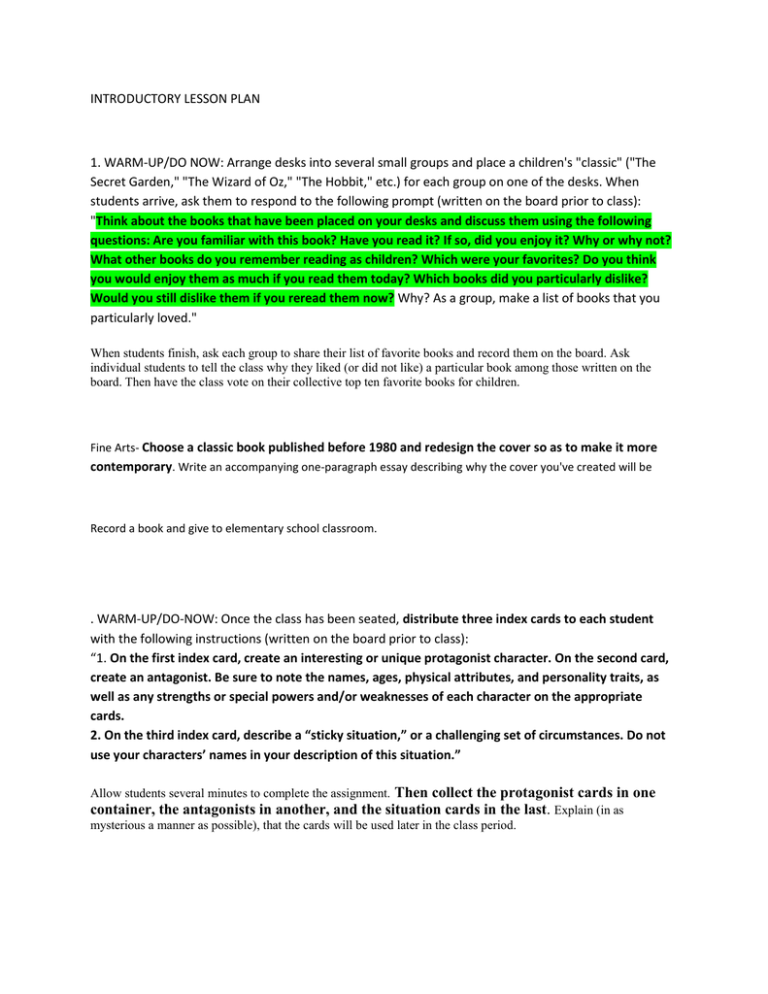INTRODUCTORY LESSON PLAN 1. WARM
advertisement

INTRODUCTORY LESSON PLAN 1. WARM-UP/DO NOW: Arrange desks into several small groups and place a children's "classic" ("The Secret Garden," "The Wizard of Oz," "The Hobbit," etc.) for each group on one of the desks. When students arrive, ask them to respond to the following prompt (written on the board prior to class): "Think about the books that have been placed on your desks and discuss them using the following questions: Are you familiar with this book? Have you read it? If so, did you enjoy it? Why or why not? What other books do you remember reading as children? Which were your favorites? Do you think you would enjoy them as much if you read them today? Which books did you particularly dislike? Would you still dislike them if you reread them now? Why? As a group, make a list of books that you particularly loved." When students finish, ask each group to share their list of favorite books and record them on the board. Ask individual students to tell the class why they liked (or did not like) a particular book among those written on the board. Then have the class vote on their collective top ten favorite books for children. Fine Arts- Choose a classic book published before 1980 and redesign the cover so as to make it more contemporary. Write an accompanying one-paragraph essay describing why the cover you've created will be Record a book and give to elementary school classroom. . WARM-UP/DO-NOW: Once the class has been seated, distribute three index cards to each student with the following instructions (written on the board prior to class): “1. On the first index card, create an interesting or unique protagonist character. On the second card, create an antagonist. Be sure to note the names, ages, physical attributes, and personality traits, as well as any strengths or special powers and/or weaknesses of each character on the appropriate cards. 2. On the third index card, describe a “sticky situation,” or a challenging set of circumstances. Do not use your characters’ names in your description of this situation.” Then collect the protagonist cards in one container, the antagonists in another, and the situation cards in the last. Explain (in as Allow students several minutes to complete the assignment. mysterious a manner as possible), that the cards will be used later in the class period. Further Questions for Discussion: -What is your favorite book? What elements or literary devices do you find most enjoyable? Does it have a happy ending, or does it end in a less conventional way? each outline a new story in which this older character will resume the lead role. ): "Who are your favorite child or adolescent characters from literature (children's stories, fairy tales, novels, etc.)? Name at least two from different stories. For each, respond to the following questions: How do you identify with this character? How would you describe his or her personality traits? How would you describe his or her physical appearance? What makes this character interesting?" After a few minutes, allow students to share their responses, listing the names of the characters on the board. As students will be expanding upon this exercise in the main activity of the lesson, you may wish to add a few additional characters to the list for greater variety. Possible characters include Huckleberry Finn, Little Red Riding Hood, Scout Finch, Ponyboy Curtis, Christopher Robin and Pippi Longstocking. Rewrite a myth, folktale or fairy tale to be set in your own community in the present time. Make to bring the book of his or her choice to class if possible. If the book is unavailable, an excerpt or summary will suffice. (Most books have excerpts or summaries online.) Also, have each student write down his or her name, the title of his or her favorite book, and a one-line plot summary on a slip of paper. 4. Write a modern or unique version of your favorite children's book. Consider which elements, objects, modes of transportation and communication, obstacles, etc. would be different and why. If applicable, create new artwork to accompany your story.



